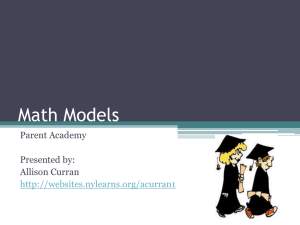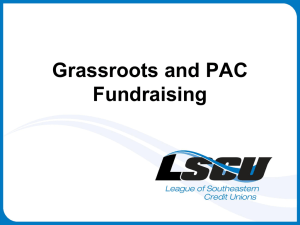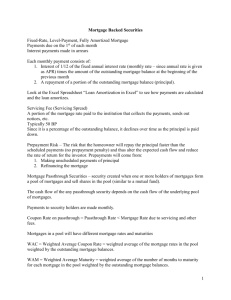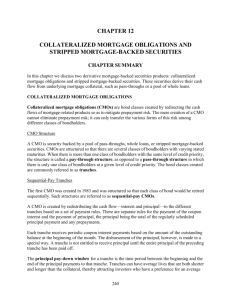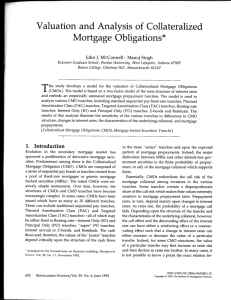Chapter 12
advertisement
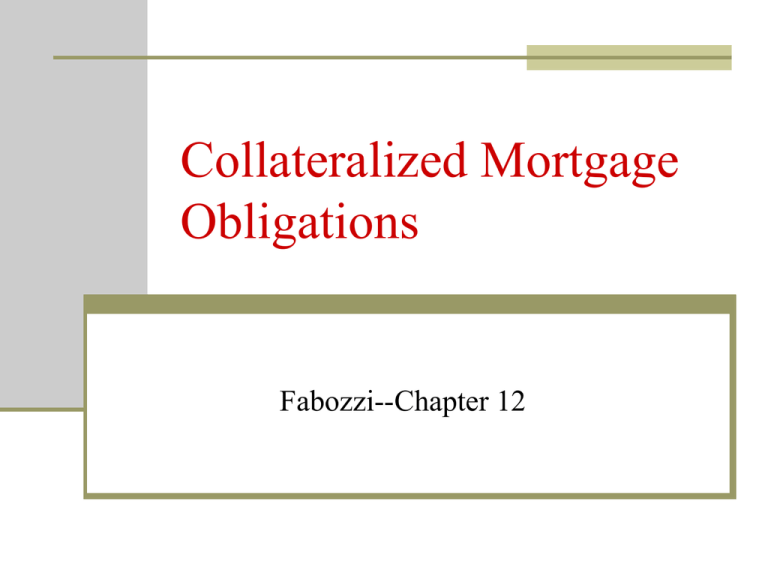
Collateralized Mortgage Obligations Fabozzi--Chapter 12 Introduction to CMOs The major risk associated with agency pass-throughs is prepayment risk. Many investors wanted securities with predictable maturities. In 1983, CMOs were created to reduce prepayment risk. CMOs are like MPT in that cash flows come from a large pool of mortgages: However, streams of principal and interest are distributed to different classes (called tranches) of bondholders. Each bond (tranche) usually has a different principal, coupon rate, maturity, and prepayment risk. The most basic type of CMO is called a sequential CMO (or sequential-pay CMO): Comprises three or four tranches that mature sequentially. Example of Sequential Pay CMO Suppose there is an underlying pool of mortgages with a face value of $750 million. Four different bonds (tranches) are issued. Tranche Maturity (months) A 24 to 48 B 60 to 84 C 120 to 144 Z 180 to 288 Total Principal All tranches receive interest payments from the pool of mortgages. However, only tranche A receives 300,000 principal (scheduled and prepays) until 200,000 the tranche has been paid off. 100,000 Then, tranche B will receive principal payments until it is paid off, and so on. 150,000 The principal paydown window 750,000 (maturity) is based on some assumed PSA speed (e.g. 165 PSA) Tranche The Z-Tranche One tranche (the Z-tranche) receives no interest: Maturity (months) Principal A 24 to 48 300,000 B 60 to 84 200,000 C 120 to 144 100,000 Z 180 to 288 150,000 Total 500,000 Instead, interest going to the Z-tranche is used to speed up the principal payoff of the other tranches. This protects other tranches from extension risk and helps stabilize the prepayments of other tranches. Z-tranche receives no interest or principal payments until all other tranches have been paid off (behaves like zero-coupon bond). Z-tranche bond investors have less reinvestment risk since they receive nothing until all other tranches mature. A CMO may have no Z-tranches, or it can have several. Floating-Rate Tranches Many financial institutions prefer floating-rate assets (to match their liabilities). This sparked the creation of floating rate tranches. Floating-rate tranches are created from fixed-rate tranches by creating a floater and inverse-floater Floaters (and inverse floaters) can be created from several tranches, one tranche, or a portion of one tranche. Tranche Par Coupon Tranche Par Coupon A 300,000 7.5% A 300,000 7.5% B 200,000 7.5% B 200,000 7.5% C 100,000 7.5% FL 75,000 LIBOR1 + 0.50 Z 150,000 7.5% IFL 25,000 28.5 – 3(LIBOR1) 150,000 7.5% Z Comments on Floating-Rate Tranches Interest rate payments on a floating-rate tranche varies due to: Changes in interest rates. Prepayments (reduces principal and reduces interest payments). The inverse-floater rate is: K – L (LIBOR1) K = the cap interest rate for the inverse floater. L = the coupon leverage NOTE: the higher L is, the more that the inverse floater’s coupon changes for a given change in LIBOR1. K and L are set so that: FL coup rate + IFL coup rate = Original tranche coup rate Example: 0.75 (FL rate) + 0.25 (IFL rate) = 7.50% PAC Tranches In the 1980s, there corporate bond market faced two trends, both unattractive to investors: 1. Increased event risk. 2. A decline in the number of AAA-rated bonds. Investors liked the safety of MBSs but increasingly demanded corporate bond like structures: A “bullet” maturity, or A sinking fund schedule of principal payment. Firms began offering structures that are now referred to as Planned Amortization Class (PAC) bonds. PAC bonds offer greater predictability of cash flow, much like a sinking fund does for corporate bonds. PAC Bonds PAC bonds have a fixed principal payment schedule unless prepayments are drastically different than expected: The greater principal repayment certainty comes at the expense of non-PAC tranches called support or companion bonds. How do PAC tranches work? Prepayment speeds for PAC tranches are assumed to be between 90 PSA and 300 PSA, and scheduled principal payments will be based on the minimum of the two. As long as prepayments are between 90 PSA and 300 PSA, principal payments will be as scheduled. If speed is slower than 90 PSA or faster than 300 PSA (a broken PAC), then principal payments will not materialize as scheduled. Different PAC collars can be used (e.g., 75 PSA and 400 PSA). A CMO can have more than one PAC tranche. Comments on PACs With MBSs it is impossible to make prepayment risk disappear, even for CMOs. The reduction in prepayment risk must come from somewhere! That “somewhere” is the support bonds: Support bondholders must forego principal payments if PAC collateral prepayments are slow. Support bondholders receive no principal until the PAC bondholders receive their schedule principal payments. Important point: The prepayment protection offered to PAC bonds hinges on the amount of support bonds outstanding. If the support bonds are paid off due to faster than expected prepayments, then the PAC protection disappears (and the PAC becomes a sequential-pay CMO) Support Bonds and PACs Will the PAC schedule be satisfied if prepayments are faster than the upper collar? (suppose we have 500 PSA). The answer is it depends on: When speed first increases to 500 PSA (the later the better) What the speed is prior to increasing to 500 PSA (if it was at 90 PSA that’s much better than being at 300 PSA). In fact if speed is on the slower end of the collar, several consecutive months at 500 PSA may have little effect. Will the PAC schedule be satisfied if prepayments stay within the collar? It depends on where speeds are within the collar and when. Effective Collar (End Class 11/24) Often initial collars are not particularly useful for assessing the prepayment protection for a seasoned PAC bond. A better measure for seasoned PAC bonds is the effective collar: This is the lower and upper PSA that can occur in the future and still preserve the scheduled principal payments. The effective collar changes each month: If speeds remain below the upper PSA, then the upper PSA will increase over time because there is greater support than originally expected. If speeds remain below the lower PSA, then the lower PSA will increase over time because, it will take faster prepays to make up the shortfall needed for the scheduled PAC prepays. Ways To Create Greater PAC Protection Lockout structure: Issue fewer PAC bonds relative to support bonds. Especially issue fewer PACs with shorter maturities (when the mortgages are paying a greater proportion of interest relative to principal). Reverse PAC structure: Alter the payment rules so that excess principal payments go to the longest maturity PAC. Other PAC Tranches Targeted Amortization Class Bonds (TAC Bonds) Very Accurately Determined Maturity Bonds (VADM Bonds) Interest-Only Tranche Principal-Only Tranche Notional IOS TAC Bonds Are like PAC bonds except have a single PSA: Principal payments will be met only if a single prepayment rate is met. Provides protection against contraction risk, but not extension risk (i.e., only one-sided payment protection). At other prepayment rates, TACs experience either excess or shortfalls. Offer more stability than sequential-pay CMO but less than a PAC. VADM Bonds A CMO structure where Z-bond interest accrues and is used to pay interest and principal on a VADM bond as scheduled. The VADM tranche receives scheduled prepayments even if no prepayments are made on the pool of underlying mortgages. VADMs have considerable protection against extension risk and some protection against contraction risk. Interest- and Principal Only Tranche Some bond classes are created so that they receive all the interest or all principal from a pool of mortgages. These are called either an IO bond class or PO bond class. Used in creating stripped mortgage backed securities. Notional IOS This is an interest-only tranche with no physical principal (it is notional). Most CMO deals pay a different coupon rate for each tranche: Coupon rates are based on the term structure of interest rates, average life of the tranche, risk of the tranche, etc. Suppose the collateral (pool of mortgages) is paying 7.50%, but a particular tranche receives only 6.0%: Where does the excess 150 bps go? To the notional tranche. The notional amount is the amount that yields the desired coupon rate. Support Bonds These are the bonds that provide prepayment protection for PAC tranches. They are most exposed to prepayment risk. Support bonds themselves can be further partitioned with into different classes of support bonds: A PAC schedule can be formed from one of these classes and supported from the cash flows of subordinate support bonds (called PAC II bonds). PAC II bonds are more risky than PAC bonds, but offer higher yields. Likewise there are PAC III bonds (formed from the cash flows from support bonds of PAC II bonds) can be created. CMO Credit Risk As with mortgage pass-throughs, CMOs are classified as agency CMOs and non-agency CMOs: Credit risk depends on whether the issuer is an agency (Freddie Mac, Fannie Mae, or Ginnie Mae) or a private institution. Non-agency CMOs are classified into two types: Private-label CMO – collateral for the CMO is a pool of agency (and therefore guaranteed) pass-throughs. Whole loan CMO – collateral for the CMO is a pool of unsecuritized mortgage loans. Today, the most common type of non-agency CMO is a whole loan CMO. Stripped MBS – PO Strips Principal-Only (PO) Strips: A PO security is purchased at a substantial discount from par value. The yield realized by the investor depends on the speed of prepayments: Faster prepayments→higher yield Slower prepayments →lower yield Example: Consider $400 million par value 30-year mortgages purchased at $175 million. The PO strips will increase $225 million to $400 million over 30 years if there are no prepayments. However, if interest rates drop, prepayments could occur rapidly causing the investor to reap the $225 million much sooner. PO strip prices move inversely with mortgage rates. Stripped MBS – IO Strips With an IO strip, there is no par value. The IO investor wants slow prepayments. Why? The interest payment received depends on the principal outstanding. As principal is paid, the outstanding balance declines and interest payments decline. If prepayments are too fast, the interest received may be less than the price paid for the IO. Interestingly, IO strip prices tend to move with mortgage rates.





